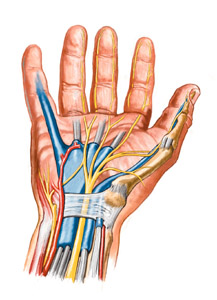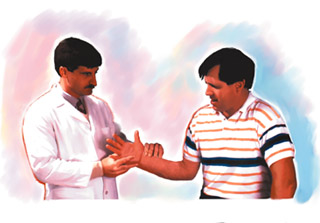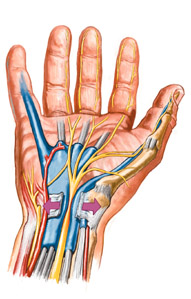|
Home
Shoulder Surgery
Knee Arthroscopy
ACL Reconstruction
Tennis Elbow
Carpal Tunnal
Knee Replacement
Hip Replacement |
Carpal Tunnel Syndrome
When you stop and think, we have been given two remarkable
instruments to help us in life: our hands.
Our hands distinguish us from the rest of the animal world. They
are capable of an amazing variety of functions. Our hands can be used
to grip like a vice, explore the world, bring food to our mouths or
play the violin.
As our hands are used and overused throughout life, it is not
surprising that they can become a source of pain.
Carpal tunnel syndrome is only one of many causes of hand pain. The
symptoms can be minor or severe, and sometimes disabling.
Carpal tunnel syndrome occurs more frequently in women and
sometimes starts during pregnancy, but also can occur in men. Although
carpal tunnel syndrome may be aggravated by work, it frequently occurs
in people who are not working with their hands. It is sometimes
associated with medical illness, but can occur for no apparent reason.
|
 |

|
Carpal tunnel syndrome is related to pressure on the
median nerve which is one of three important nerves that supply
sensation to the hand.
As the nerve travels from the neck to the hand, it passes through a
tunnel in the wrist: the carpal tunnel.
Like all nerves, the median nerve is a delicate structure. In the
tunnel, the median nerve is accompanied by nine tendons, which are
tough and fibrous.
The carpal tunnel has a normal resting pressure. In most of us the
pressure is low. In some of us, the pressure is higher.
Any activity that raises the pressure in the carpal tunnel affects
the tendons and nerve. The tendons are durable and tolerate the
pressure well. In contrast, the median nerve is delicate and is
vulnerable to pressure changes. Even mild increases in pressure that
are sustained over a prolonged period of time can result in symptoms
of pain and numbness.
Factors that increase the pressure within the carpal canal, include
bending at the wrist and repetitive wrist motion.
|
As the pressure within the carpal canal increases, the median nerve is
compressed and symptoms of unpleasant tingling and numbness are
experienced. In most cases the little finger is spared.
If you have pain, numbness, and tingling in the fingertips of your hand
with manual activity and are awakened with these symptoms at night, you
may have carpal tunnel syndrome—ask your doctor.
Be sure to describe the location of your pain to your doctor. Also,
mention the activities which aggravate and relieve your pain.

|
Your doctor will examine your hand and look for
changes in muscle contour and sensibility.
Your doctor may order blood tests and an X-ray. Frequently
electrical studies are needed.
Nerves are like wires; they conduct electricity. If a nerve is
compressed the speed of electrical conduction is slowed. In carpal
tunnel syndrome, the speed of conduction of the median nerve is
decreased. This delay in conduction can be measured.
Although carpal tunnel syndrome can be painful, even disabling,
there are many things which you and your doctor can do to relieve your
pain.
|
 | Wrist splints can be used to decrease bending.
|
 | Hard splints can be used at night, and soft splints can be used
during the daytime depending upon your needs.
|
Your doctor may prescribe medications. Sometimes steroid injections are
indicated.
If you believe your problem is aggravated at your work, sometimes
simple changes can make a difference. For people who sit at a desk or
keyboard, the working surface should be adjusted so that the majority of
work can be performed with the wrist in neutral position—not bent upwards
or downwards. This can sometimes be accomplished by simple adjustment of
the chair.

|
Many people are required to perform repetitive
activities at work. With careful planning some activities can be
alternated.
If conservative measures fail, or if your condition is severe and
affects the muscles in the hand, your doctor may recommend surgery.
Fortunately, the roof of the carpal tunnel is covered by a fibrous
ligament, which can be released by your surgeon.
Remember, the problem of carpal tunnel syndrome is related to
pressure on the median nerve. If the roof of the carpal tunnel is
opened, even slightly, studies indicate that the volume of the carpal
tunnel increases by 26%—enough to relieve most of the pressure on the
nerve.
If surgery is performed, it is unnecessary to stay in the hospital.
The type of anesthetic can be chosen by you and your doctor.
|
Although you may have carpal tunnel syndrome in both hands, usually
surgery is staged, so that it is performed on one hand followed later on
the other hand.
After surgery, your hand will be covered by a bandage. It is important
to keep this dry, and to elevate the hand so that it is above the heart as
much as possible. Your doctor will prescribe medication for pain, but if
the pain becomes severe, call your doctor.
In a few days, your doctor will remove the dressing and apply a smaller
dressing. In 2 to 3 weeks, he will remove the stitches.
 | It is important to keep the hand dry until the sutures are removed
by your doctor.
|
 | As in all operations, problems can occur. Call your doctor for
excessive pain, swelling or numbness.
|
You can return to normal activity as recommended by your doctor. At
work, try to avoid continuous repetitive movements by alternating
activities as much as possible.
Be kind to your hands
Your hands are remarkable instruments which can serve you well
throughout life, but it is important that you take good care of them.
Do not use your hands as a hammer. Avoid trauma, as much as possible
and use a real hammer.
Wear protective gloves when doing hard work or when in cold weather.
If you have surgery, finger motion can reduce swelling. Move your
fingers, even while wearing your splint. Do not drive until you are able
to make a firm fist.
We are lucky to have our hands. They have been given to us to use
throughout life. If we are kind to our hands, they will be kind to us.
Your orthopaedist is a medical doctor with extensive training in the
diagnosis and nonsurgical and surgical treatment of the musculoskeletal
system, including bones, joints, ligaments, tendons, muscles and nerves. |
History
Appointments
Hospital
Medications
Glossary
News
Contact Dr.Franks |








